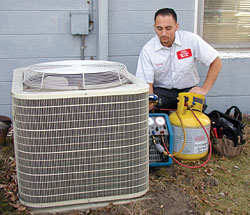
They are doing so because it is the least expensive way to do business, and neither contractor nor supplier are much concerned about the Environmental Protection Agency (EPA) actually cracking down on what amounts to illegal practices.

They are doing so because they sense environmental correctness is the right thing to do and, in the long run, makes good business sense. Perhaps they also fear a hefty fine from the EPA.
So, which scenario is true?
Good question.
Good Guys, Bad Guys
It is more than likely that both scenarios are being played out today. The concern, however, is that those from the first scenario may be in the majority.Glenn Hourahan, vice president, research and technology, Air Conditioning Contractors of America (ACCA), said the association's members at a recent "town hall" meeting expressed concern that the industry may have too many folks wearing black hats.
Hourahan ticked off some concerns that had been brought to his attention from members, including the lack of apparent and vigilant enforcement of regulations regarding CFCs and HCFCs. Some members have alleged that there was not enough checking of the technician certification cards needed to purchase refrigerants, while others pointed to the small amounts of refrigerant coming back for reclamation, leading to speculation about venting and reliance on virgin refrigerants.
Hourahan also said many ACCA members have expressed frustration at an infrastructure that makes it difficult to route refrigerant to proper reclamation sites.
"Good contractors do what is right and it costs them money. For less responsible contractors, it is a continuation of the old business practices," said Hourahan. "Obviously, it is costing the responsible business more money to be in compliance."

Enforcement Needed?
The issue of enforcing regulations is not as clear-cut as having an EPA inspector monitoring every jobsite, ready to slap a fine on a contractor the first time an excessive amount of refrigerant sails into the atmosphere.In extended comments about EPA actions in the April 12 issue of The News, the EPA's Julius Banks said the agency relies on - in polite terms - "self governing" within the industry.
"Actions are based primarily on tips and complaints from people who write or call our hotline," said Banks, who added the EPA "monitors activities of contractors mainly through complaints from competitors and their [customers]."
Banks said he thinks the good guy-bad guy issue tips more toward the white hats. "Most contractors are good businessmen who properly attempt to recover refrigerant," said Banks.
Hourahan mentioned that ACCA membership wants the EPA to become more aggressive in pursuing violators.
"A lot of businesses don't worry at all about being turned in," said Hourahan. "The EPA needs to ensure compliance by hitting noncompliant contractors and distributors where it hurts the most - in the pocketbook."
Hourahan admitted that some governmental policies might impede such aggressiveness. He noted that fines collected for venting violations go into the general government coffers, rather than directly back to the EPA to augment enforcement activities. Were the money to come back to the EPA, it could fund more aggressive enforcement and inspection activities, Hourahan believes.
The Card, R-22 Issues
The EPA certification card issue extends beyond what's happening at the counters, said Hourahan. He said a system should be put in place that requires cardholders to renew their licenses every five years. The licensing process should demonstrate that cardholders are keeping up with the rapid changes occurring with new refrigerants, their safe handling and use, as well as evolving applications.Hourahan said contractors advise that the full transactional cost of used recovered, recycled, and reclaimed R-22 (and other refrigerants) is still more costly than purchasing virgin R-22, the most common refrigerant used in residential and light commercial applications in the United States.
Some industry officials said R-22 could have a volatile future as it moves towards complete phaseout over the next 15 years. Factors such as manufacturing plant shutdowns, plant swings to produce other products, inventory control, global demand, increased energy costs, and transport costs could have a more immediate effect on supplies and costs.
Hourahan noted that as of mid-June, ACCA members were not reporting any shortages or significant price spikes.
And What About HFCs?
This spring, when the EPA listed its latest rulings concerning refrigerants, it did not place the same restrictions on HFCs as it did on CFCs and HCFCs. An HFC venting prohibition is now in place, but HFCs are not governed by maximum leak rate standards, vacuum specifications, recovery/recycling equipment certification, reclamation requirements, or sales and use restrictions (as are CFCs and HCFCs). As an example, a refrigerant certification card is not needed to purchase any of the HFCs. Today, small containers of HFC-134a are available from automotive parts distributors for consumer purchase and use.The EPA argument is that many years ago Congress told the EPA to go after ozone-depleting gases - i.e., CFCs and HCFCs.
As a result, the EPA did so. HFCs are global warming gases, but they are not ozone depleting. Therefore, the EPA said it believes that it lacks the authority to regulate HFCs unless specifically directed to do so by Congress.
Referencing the new HFC venting prohibition, Hourahan said the EPA is within its mandate to regulate HFCs. He said it is ACCA's position that EPA needs to extend the full set of CFC and HCFC requirements onto HFCs and then rigorously enforce all such regulations. He said failure to do so might result in a worldwide perception that the United States is not serious about safeguarding the environment from avoidable releases of man-made chemicals.
Pressure in Europe to phase out HFCs because of global warming concerns has spurred research into other refrigerant possibilities. However, Hourahan said, some contractors maintain that some of the alternatives are either not as energy efficient or not as safe as the refrigerant options currently available.
"Improper refrigerant HCFC/HFC stewardship today may lead to a future that compels the use of alternative working fluids that inadequately meet the needs of customers, while greatly increasing cost and liability exposures to contractors," Hourahan said.
"ACCA contractors seek to ensure future availability of today's efficient and safe refrigerant options by following EPA regulations and other good practices," he concluded. "Perhaps while waiting for refrigerant regulation changes, white hat contractors should assist EPA's enforcement mission by keeping their whistles on the ready."
Publication date: 07/05/2004


Report Abusive Comment